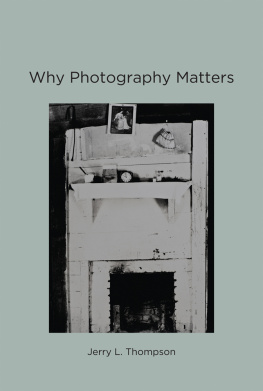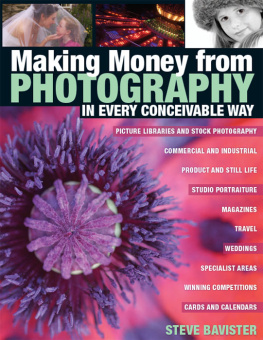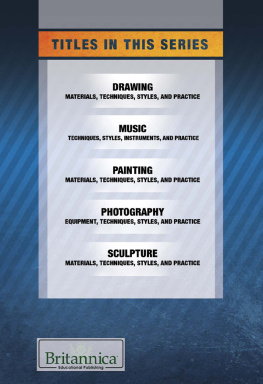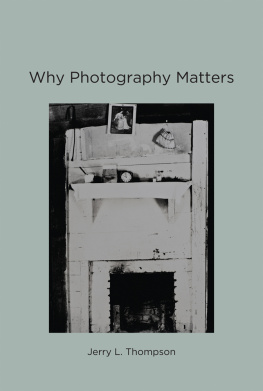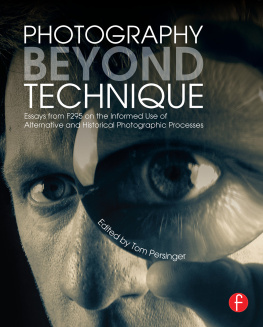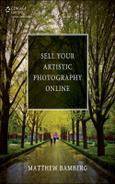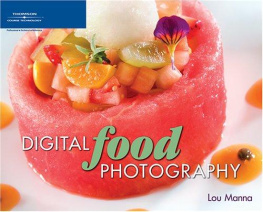Why Photography Matters
Why Photography Matters
Jerry L. Thompson
The MIT Press
Cambridge, Massachusetts
London, England
2013 Jerry L. Thompson
All rights reserved. No part of this book may be reproduced in any form by any electronic or mechanical means (including photocopying, recording, or information storage and retrieval) without permission in writing from the publisher.
This publication is made possible in part by the Fondation Jan Michalski pour lEcriture et la Littrature, Switzerland, and the Gladstone Gallery, New York.
Library of Congress Cataloging-in-Publication Data
Thompson, Jerry L.
Why photography matters / Jerry L. Thompson.
p. cm.
Includes bibliographical references.
ISBN 978-0-262-01928-6 (hardcover : alk. paper)
ISBN 978-0-262-31687-3 (retail e-book)
1. PhotographyPsychological aspects.
2. PhotographyPhilosophy.
I. Title.TR183.T4753 2013770dc23
2012044048
10 9 8 7 6 5 4 3 2 1
d_r1
I
Like a photograph taken of a stranger, my title is a theft.
In 2008 a book appeared called Why Photography Matters as Art as Never Before. It is quite long, running to over 400 pages, and I have not mastered all its arguments. Nor am I convinced that some of the artists it discusses merit so much attention as photographers. But I so admire the breathless urgency of the title that I have lifted its first three words for my own, much briefer, effort. My target length is best measured not in pages, but in words.
And brief I intend this effort to be. Brevity, concision, abruptness: all qualities appropriate to a discussion of the most modern of artistic mediums. Brevity and abruptness were qualities admired by modernists as various as Andrei Bely, the Russian author who set the pace of his disjointed novel St. Petersburg (1913) to the ticking of a revolutionarys time bomb, and the young Walker Evans, who in 1931 published a brief essay urging postwar vision to explore swift chance, disarray, wonder, and experiment. Our modern love of speed, chance, and disarray will not only direct the progress of this essay: further on, the need to move fast will play a role in its argument as well.
Why Photography Matters: the title and the question it implies echo the urgency of another revolutionary title: N. G. Chernyshevskys What Is to Be Done? Then (1863), political revolution was sweeping Europe, and would before too long threaten to spill over into Fortress America. Now (2012), the capitalist economies of Europe and America seem to be running out of gas: stagnation and entropy are greater threats than revolutionary upheaval. What is the urgency of a halting limp or a slowing crawl? And what has photography to do with it, that we should ask breathless questions about its importance now?
Well might we ask what photography has to do with it. Much of the photography we see in prestigious museums and lavish publications is decorative self-indulgence. Elegant, knowing riffs on the history of painting fill our commercial galleries and bring the highest prices at auction. Such work looks like a symptom of unraveling, a loss of vital purpose. Shouldnt photographywhich began as a hyperdetailed record of our shared visible worldprovide a close, critical examination of that world, the kind of jarring irritant able to rouse viewers out of a complacent, forgetful slumber, and into a wakeful regard of what is?
Four references and two opinions set a spare stage. Against this provisional backdrop, let me reask the title question: Why does photography matter, and why now?
Photography matters now for two interrelated reasons: One, because of how it works, not only as an artistic but also as an epistemological medium; and Two, because it presents an instructive example of what might be called present-day understanding. How we nowtodayunderstand what photography is and how it works tells us something about how we understand anything. And it may appear that how we understand anything is not unrelated to how photography works.
II
Let me begin with Reason One, how photography works.
The camera is not only a tool for generating images.
Studio artists today use cameras to generate the pictorial raw materials they need in order to create works expressive of their individual talents and personal visions. For a studio artist, the camera is a source of material. The artist provides the form, shaping what the camera supplies into what the viewer sees as a work of art. The content of the artworkwhat it has to say to the viewer, the experiences (emotional and intellectual) it prompts the viewer towardthis content comes from the artist, as it does when the work of art is a painting (or other kind of imagined image). The viewer contemplates the artists vision. What the artist presents, as her work progresses, is a progressively deeper exploration of that vision.
The viewer who follows the work of an artist over time may come to know many facts about the world, but that viewer comes to know those facts incidentally, the way a reader of novels by, say, Thomas Pynchon comes to know about the trajectories of ballistic missiles or the progress of E. coli infections. What the serious viewer comes to know about, what he could not learn from a technical manual or guidebook, however, is something else: the visionthe intellectual and moral worldof the artist. We dont read Pynchon to learn about physics and military history; if we read him seriously we read him to learn about his vision of contemporary reality. We read him to come into contact with what ever since Immanuel Kants formulation of 1791 has been called his genius: his original, and unique, understanding of how the world works. According to Kant, what genius produces illuminates Natures rules, rules the genius him/herself can embody in his/her work but not explain, rules some later intelligence may be able to analyze and make understandable to others.
A studio artist works like a novelist. He or she may pay a great deal of attention to the details of everyday visible reality, but what he or she adds to those observations is the something else, the shaping form supplied by his or her genius. The details figure in, but they are not the main point. Walker Evans wrote in an undated note to himself that anyone who goes to Botticelli to learn about the dress and manners of the fifteenth century is a pedant and a fool. Few scholars of the future who look at Jan Groovers breakthrough still-life arrangements of kitchen utensils will spend much time considering the development of the colander in the 1970s. The main point is not a compilation of facts about the objects seen, but the genius of their combination into an original composition.
Groover (d. 2012) was, as also was the Evans (there were more than one) who wrote that epigram, not only a photographer but also an artist. But not all artists who use photography use it in the same way. To repeat: the camera is not only a tool for generating images.
To find a sharp contrast to what I have been calling a studio artist we need look no further than the first book of photographs ever published, William Henry Fox Talbots The Pencil of Nature (1844). This book consists of a number of the earliest photographs made, each pasted on a page with a brief essay/caption printed across from it. Here is an excerpt from one of the captions:
It frequently happens... and this is one of the charms of photographythat the operator himself discovers on examination, perhaps long afterwards, that he has depicted many things he had no notion of at the time. Sometimes inscriptions and dates are found upon the buildings, or printed placards most irrelevant, are discovered upon their walls: sometimes a distant dial-plate is seen, and upon itunconsciously recordedthe hour of the day at which the view was taken.
Next page
